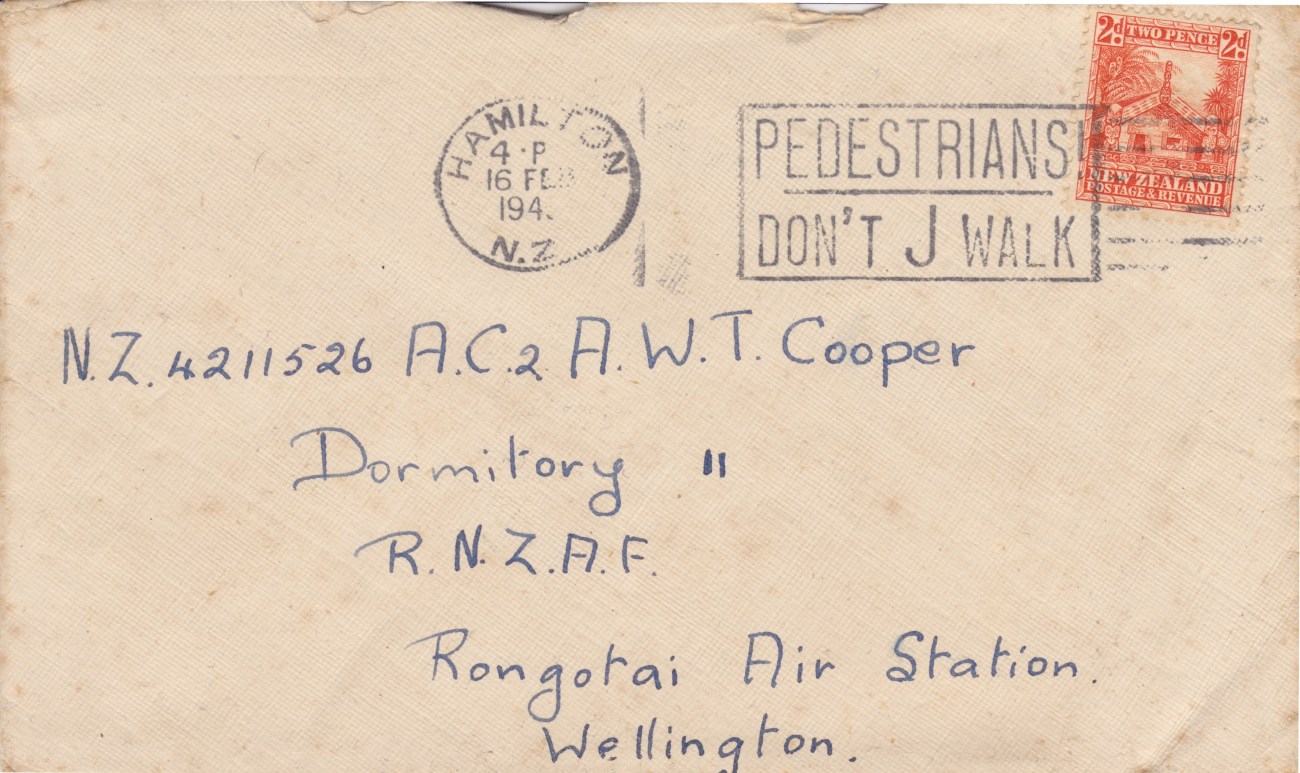Today I have another couple of envelopes and another story, this time from wartime Wellington – a city that has had a bit of a shaky time lately.
I came across this pair of covers (fancy philately term for used envelopes) back when I was a teenager. At the time I had a keen interest in the history of aviation and New Zealand’s wartime air bases. I knew veterans who once flew Hudson bombers out of the air base in Nelson, my grandfather regaled me with stories from his time at Wigram in Christchurch and I was even a member of a 1940’s Royal Air Force re-enactment group that used to put on displays at airshows. It was around about this same time that I started keeping an eye out for covers addressed to or sent from wartime military bases.
These two covers were sent from Rotorua and Hamilton to a serviceman at the RNZAF base at Rongotai Air Station. If you are a New Zealander then I can almost guarantee that you’ve been to Rongotai – today it is more commonly known as Wellington International Airport. It is a site with an interesting history.
Due to recent events Wellingtonians might want to skip this next bit….. the area was actually underwater until relatively recently when it was raised up by a series of earthquakes. Check out this awesome edited aerial photo that shows how much the harbour has changed. Until the mid-fifteenth century most of the flat land now occupied by the airport was underwater, in fact the only part that wasn’t submerged was the hill that the control tower is positioned on today. Another large quake in 1855 also contributed to the changing landscape.
In the early twentieth century the flat land at Rongotai played a principal role in Wellington’s early aviation and by the mid 1930’s there was a working aerodrome on the site. However a war was on its way, and so was a big birthday party.
In 1940 the flat land was the venue for New Zealand’s Centennial Exhibition – a significant event that I’ll share some mementos and stories from another day. While civilians and soldiers perused the cultural delights, zapped around the grounds on miniature trains and had a laugh on the dodgems the RNZAF were using the nearby air strip to train recruits for the war in Europe.
After the centennial celebrations were over the empty exhibition buildings were put to good use and did their bit for the war effort.

Royal New Zealand Air Force Technical Training School, Rongotai. Raine, William Hall, 1892-1955 :Negatives of New Zealand towns and scenery, and Fiji. Ref: 1/1-021676-G. Alexander Turnbull Library, Wellington, New Zealand. http://natlib.govt.nz/records/22591838

Royal New Zealand Air Force Technical Training School, Rongotai. Raine, William Hall, 1892-1955 :Negatives of New Zealand towns and scenery, and Fiji. Ref: 1/1-021676-G. Alexander Turnbull Library, Wellington, New Zealand. http://natlib.govt.nz/records/22591838
It must have been a little surreal training for war among the grand exhibition buildings, once a scene of cultural festivities but now absorbed into the war machine. This was the world that those two envelopes were delivered to. For more details about exactly which units were based at Rongotai during the war take a look at this fantastic site.
One last thought, I wonder if the recipient of the two envelopes found it just a little bit ironic that out of all the dangers that 1943 had to offer that the one that the postal service most wished to bring to his attention was the perils of J walking.
Along with just about every other 1940’s public service announcement, this amuses me.
© Lemuel Lyes
Categories: Aviation, Second World War, Uncategorized, Wellington



Cool photos and memorabilia – thanks for sharing. That old De Havilland factory was the main air terminal right into the early 1990s. One of several things on a list of Embarrassing Monuments to Inactivity, but the new terminal’s great.
I just flew into that airport on Monday – a lovely sunny and calm day, though there have been times when I’ve landed there and almost bent to kiss the ground when I got out of the aircraft. Apparently Kingsford Smith was queried about the place in the late 1920s and insisted that the main airport should be built anywhere but. Bureaucrats being what they are… 🙂
As a youngster I have fond memories of going out to the end of the airport on windy days to watch the aircraft for entertainment – before boarding a tiny metroliner to fly home at the end of the holiday!
Also one of my earliest footage research tasks involved digging through TVNZ’s ‘weather compilations’ for the most jaw dropping footage they had of Wellington airport on windy days. Not for the fainthearted! That airport is an experience for sure!